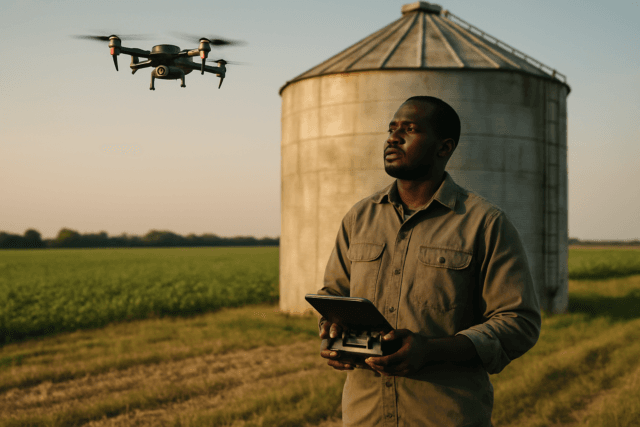The rise of e-commerce has dramatically increased the demand for faster, more efficient delivery services, pushing companies to explore innovative solutions like drone delivery. As unmanned aerial vehicles (UAVs) become a more tangible reality for “last-mile” logistics, a critical question emerges: what is their environmental impact compared to conventional delivery methods?
While often touted as a greener alternative, the environmental benefits of drone delivery are not always clear-cut and depend on a variety of factors, including operational scale, geographical conditions, package size, and the energy sources used to power them.
Unpacking the Environmental Impact of Last-Mile Delivery
Traditional last-mile delivery, primarily relying on ground vehicles like trucks and vans, contributes significantly to urban carbon emissions and air pollution. This final leg of the delivery process is particularly environmentally damaging, accounting for a disproportionate amount of urban pollution. The sheer volume of deliveries, especially with the demand for faster shipping, means more vehicles on the road, leading to increased traffic congestion and greenhouse gas emissions. Last-mile delivery is responsible for an estimated 30% of all greenhouse gas emissions in cities, 40% of fine particle pollution, and 50% of diesel consumption.
Energy Consumption: Drones vs. Trucks
The energy efficiency of drone delivery compared to conventional trucks is a key area of study. While an electric drone uses significantly less energy per mile than a heavy diesel truck, the overall energy consumption needs to be allocated per package, considering that a truck can carry many packages at once, while a drone typically delivers one package per flight.
Studies have shown varying results depending on specific scenarios:
- Small Packages & Short Distances: For delivering small packages over short distances, drones can be more energy-efficient and produce fewer greenhouse gas emissions. A study in California found drone delivery of a small package resulted in about 0.42 kg of greenhouse gas emissions, a 54% savings compared to the 0.92 kg from truck delivery in that state. Similarly, small drones consume up to 94% less energy per parcel than diesel trucks and 31% less than electric vans.
- Wind Conditions: Wind speed significantly influences drone energy consumption. On an “average windy day” (10 mph), delivery drones required 15.8% more energy than Battery Electric Vehicles (BEVs) but 73% less energy than diesel trucks. On “very windy days” (20 mph), drones needed five times as much energy as BEVs and 15% more than diesel trucks, suggesting drone delivery might be less efficient in windy areas.
- Larger Drones & Packages: Larger drones are generally less energy-efficient due to the increased power required for flight. For larger packages, electric-powered trucks are likely a cleaner and more energy-efficient option.
- Infrastructure Energy: The energy-intensive processes involved in drone manufacturing, maintenance, and the additional warehousing required to house and support drone fleets can add to their overall environmental footprint.
Greenhouse Gas Emissions: A Deeper Dive
Reducing greenhouse gas (GHG) emissions is a primary goal for sustainable logistics.
- Carbon Intensity of Electricity: Since drones are electric, the carbon intensity of the electricity grid used for charging is a crucial factor. In regions with cleaner energy sources, drone deliveries have a greater potential to reduce emissions. Conversely, emissions can jump by 93% in areas reliant on carbon-heavy electricity grids.
- Emissions per Package: While a single traditional delivery van may emit more CO2 equivalent (CO2e) than a drone for one package, the van’s ability to deliver multiple packages in a single trip can significantly reduce the CO2e per package. In one specific scenario comparing a drone delivering a 1 kg package over 10 km to a gasoline-powered van, the drone initially appeared to have a higher environmental impact (0.078 kg CO2e vs. 0.021 kg CO2e). However, this comparison doesn’t account for the van’s load capacity.
- Urban vs. Rural Settings: In densely populated urban areas, drones can bypass traffic congestion and reduce the need for large delivery vehicles, potentially offering substantial environmental advantages. In rural settings with greater distances between delivery points, drones may consume more energy and produce more emissions per delivery.
Noise Pollution and Other Environmental Considerations
Beyond energy consumption and greenhouse gas emissions, drone delivery introduces other environmental factors:
Noise Pollution
Drones produce a distinct buzzing noise, which can be a significant concern for communities, particularly in residential areas. While some studies suggest drones could offer a reduction in average noise levels compared to traditional transport, the repetitive nature and higher frequency of drone sounds can be perceived as more intrusive and irritating. Constant noise disruptions can negatively affect the quality of life and even increase stress levels among residents. Efforts are underway to develop quieter drone models to mitigate this issue.
Wildlife Disturbances
The proliferation of drones, especially in rural areas, raises concerns about potential disturbances to local wildlife. Regulatory frameworks will need to address these challenges to minimize environmental disruption.
Infrastructure and Urban Planning
While drone delivery may not require extensive new road networks, it necessitates specific infrastructure such as dedicated pads for loading, take-off, landing, and charging facilities. The need for additional warehouses to house drones could also contribute to the overall environmental footprint. Integrating drones into existing logistics systems to complement traditional methods, particularly for last-mile deliveries, is crucial for minimizing their environmental impact.
The Future of Delivery: A Hybrid Approach
The consensus among researchers suggests that the future of sustainable last-mile delivery likely lies in a hybrid model. This approach would combine drones for smaller, time-sensitive deliveries over short distances, especially in urban areas with clean energy grids, with optimized traditional vehicle fleets (increasingly electric) for bulk deliveries and longer routes.
To maximize the environmental benefits of drone delivery, key considerations include:
- Optimizing Delivery Networks: Designing drone routes to minimize noise exposure in sensitive areas and strategically locating fulfillment centers.
- Advancements in Technology: Continued improvements in battery life, drone design (e.g., quieter motors), and navigation systems are vital.
- Clean Energy Grids: The environmental benefits of electric drones are heavily dependent on the source of electricity used for charging.
- Regulatory Frameworks: Evolving regulations are needed to address issues like noise, air quality, and wildlife disturbances to ensure sustainable drone operations.
By carefully deploying and integrating drone technology with existing logistics, there is potential to reduce greenhouse gas emissions, alleviate traffic congestion, and improve overall energy efficiency in the freight sector.





